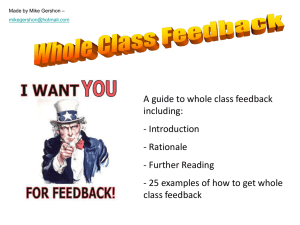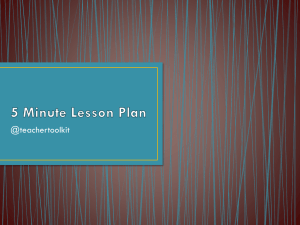Raising standards through classroom assessment
advertisement
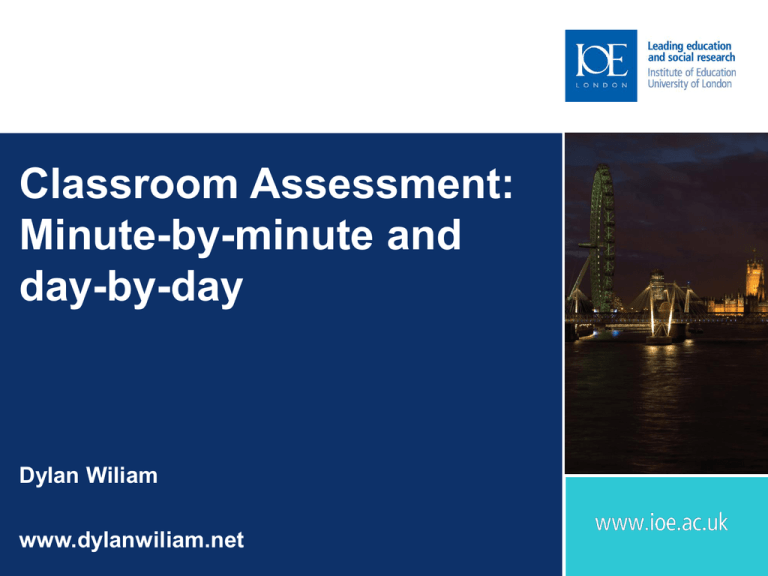
Classroom Assessment: Minute-by-minute and day-by-day Dylan Wiliam www.dylanwiliam.net Overview of presentation Why raising achievement is important Why investing in teachers is the answer Why formative assessment should be the focus Why teacher learning communities should be the mechanism How we can put this into practice Raising achievement matters For individuals Increased lifetime salary Improved health Longer life For society Lower criminal justice costs Lower health-care costs Increased economic growth Where’s the solution? Structure Smaller high schools K-8 schools Alignment Curriculum reform Textbook replacement Governance Charter schools Vouchers Technology Computers Interactive white-boards School effectiveness Three generations of school effectiveness research Raw results approaches Different schools get different results Conclusion: Schools make a difference Demographic-based approaches Demographic factors account for most of the variation Conclusion: Schools don’t make a difference Value-added approaches School-level differences in value-added are relatively small Classroom-level differences in value-added are large Conclusion: An effective school is a school full of effective classrooms How important is teacher quality? How much progress will an average student make when taught by a great teacher (i.e., the best teacher in a group of 50)? A. An extra month per year B. An extra two months per year C. An extra three months per year D. An extra four months per year E. An extra six months per year Teacher quality A labor force issue with 2 solutions Replace existing teachers with better ones? No evidence that more pay brings in better teachers No evidence that there are better teachers out there deterred by burdensome certification requirements Improve the effectiveness of existing teachers The “love the one you’re with” strategy It can be done We know how to do it, but at scale? Quickly? Sustainably? The ‘dark matter’ of teacher quality Teachers make a difference But what makes the difference in teachers? Advanced content matter knowledge Pedagogical content knowledge Further professional qualifications (NBPTS) Total “explained” difference <5% 10-15% <5% 20-25% Cost/effect comparisons Intervention Extra months of learning per year Cost/yr Class-size reduction (by 30%) 3 $30k Increase teacher content knowledge from weak to strong 1.5 ? 6 to 9 $3k Formative assessment/ Assessment for learning The research evidence Several major reviews of the research Natriello (1987) Crooks (1988) Kluger & DeNisi (1996) Black & Wiliam (1998) Nyquist (2003) All find consistent, substantial effects Types of formative assessment Long-cycle Span: across units, terms Length: four weeks to one year Impact: Student monitoring; curriculum alignment Medium-cycle Span: within and between teaching units Length: one to four weeks Impact: Improved, student-involved, assessment; teacher cognition about learning Short-cycle Span: within and between lessons Length: day-by-day: 24 to 48 hours minute-by-minute: 5 seconds to 2 hours Impact: classroom practice; student engagement Unpacking formative assessment Key processes Establishing where the learners are in their learning Establishing where they are going Working out how to get there Participants Teachers Peers Learners Aspects of formative assessment Where the learner is going Teacher Peer Learner Where the learner is Engineering effective Clarify and share discussions, tasks and activities that elicit learning intentions evidence of learning How to get there Providing feedback that moves learners forward Understand and share learning intentions Activating students as learning resources for one another Understand learning intentions Activating students as owners of their own learning Sharing learning intentions Explaining learning intentions at start of lesson/unit Learning intentions Success criteria Intentions/criteria in students’ language Posters of key words to talk about learning eg describe, explain, evaluate Planning/writing frames Annotated examples of different standards to ‘flesh out’ assessment rubrics (e.g. lab reports) Opportunities for students to design their own tests Eliciting evidence of achievement Key idea: questioning should cause thinking provide data that informs teaching Improving teacher questioning generating questions with colleagues closed vs. open or low-order vs. high-order appropriate wait-time Getting away from I-R-E basketball rather than serial table-tennis ‘No hands up’ (except to ask a question) ‘Hot Seat’ questioning All-student response systems ABCD cards, Mini white-boards, Exit passes Feedback that moves learning on Key idea: feedback should cause thinking provide guidance on how to improve Comment-only grading Focused grading Explicit reference to mark-schemes and scoring guides Suggestions on how to improve ‘Strategy cards’ ideas for improvement Not giving complete solutions Re-timing assessment (eg two-thirds-of-the-way-through-a-unit test) Students as owners of their learning Students assessing their own work with rubrics with exemplars Self-assessment of understanding Traffic lights Red/green discs Colored cups Students as instructional resources Students assessing their peers’ work “pre-flight check-list” “two stars and a wish” Training students to pose questions/identifying group weaknesses End-of-lesson students’ review …and one big idea Use evidence about learning to adapt teaching and learning to meet student needs Keeping Learning on Track (KLT) A pilot guides a plane or boat toward its destination by taking constant readings and making careful adjustments in response to wind, currents, weather, etc. A KLT teacher does the same: Plans a carefully chosen route ahead of time (in essence building the track) Takes readings along the way Changes course as conditions dictate Putting it into practice Implementing FA/AfL requires changing teacher habits Teachers “know” most of this already So the problem is not a lack of knowledge It’s a lack of understanding what it means to do FA/AfL That’s why telling teachers what to do doesn’t work Experience alone is not enough—if it were, then the most experienced teachers would be the best teachers—we know that’s not true (Hanushek, 2005; Day, 2006) People need to reflect on their experiences in systematic ways that build their accessible knowledge base, learn from mistakes, etc. (Bransford, Brown & Cocking, 1999) A model for teacher learning Content, then process Content (what we want teachers to change) Evidence Ideas (strategies and techniques) Process (how to go about change) Choice Flexibility Small steps Accountability Support Strategies and techniques Distinction between strategies and techniques Strategies define the territory of AfL (no brainers) Teachers are responsible for choice of techniques Allows for customization/ caters for local context Creates ownership Shares responsibility Key requirements of techniques embodiment of deep cognitive/affective principles relevance feasibility acceptability Teacher learning takes time To put new knowledge to work, to make it meaningful and accessible when you need it, requires practice. A teacher doesn’t come at this as a blank slate. Not only do teachers have their current habits and ways of teaching— they’ve lived inside the old culture of classrooms all their lives: every teacher started out as a student! New knowledge doesn’t just have to get learned and practiced, it has to go up against long-established, familiar, comfortable ways of doing things that may not be as effective, but fit within everyone’s expectations of how a classroom should work. It takes time and practice to undo old habits and become graceful at new ones. Thus… Professional development must be sustained over time That’s what teacher learning communities (TLCs) are for: TLCs contradict teacher isolation TLCs reprofessionalize teaching by valuing teacher expertise TLCs deprivatize teaching so that teachers’ strengths and struggles become known TLCs offer a steady source of support for struggling teachers They grow expertise by providing a regular space, time, and structure for that kind of systematic reflecting on practice They facilitate sharing of untapped expertise residing in individual teachers They build the collective knowledge base in a school How to set up a TLC Plan that the TLC will run for two years Identify 8 to 10 interested colleagues Should have similar assignments (e.g. early years, math/sci) Secure institutional support for: Monthly meetings (75 to 120 minutes each, inside or outside school time) Time between meetings (2 hrs per month in school time) Collaborative planning Peer observation Any necessary waivers from school policies A ‘signature pedagogy’ for teacher learning? Every monthly TLC meeting should follows the same structure and sequence of activities Activity 1: Introduction & Housekeeping (5-10 minutes) Activity 2: How’s It Going (35-50 minutes) Activity 3: New Learning about AfL (20-45 minutes) Activity 4: Personal Action Planning (10 minutes) Activity 5: Summary of Learning (5 minutes) The TLC leader’s role To ensure the TLC meets regularly To ensure all needed materials are at meetings To ensure that each meeting is focused on AfL To create and maintain a productive and non-judgmental tone during meetings To ensure that every participant shares with regard to their implementation of AfL To encourage teachers to provide their colleagues with constructive and thoughtful feedback To encourage teachers to think about and discuss the implementation of new AfL learning and skills To ensure that every teacher has an action plan to guide their next steps But not to be the AfL “expert” Peer observation Run to the agenda of the observed, not the observer Observed teacher specifies focus of observation Observe teacher specifies what counts as evidence e.g., teacher wants to increase wait-time provides observer with a stop-watch to log wait-times Implementations Current pilots in: Cleveland Municipal School District, OH Austin Independent School District, TX Chico Unified School District, CA Mathematics and Science Partnership of Greater Philadelphia, PA/NJ St. Mary’s County Public Schools, MD State-wide pilot in 10 schools in Vermont Further details: www.ets.org/klt Summary Raising achievement is important Raising achievement requires improving teacher quality Improving teacher quality requires teacher professional development To be effective, teacher professional development must address What teachers do in the classroom How teachers change what they do in the classroom AfL/FA + TLCs A point of (uniquely?) high leverage A “Trojan Horse” into wider issues of pedagogy, psychology, and curriculum
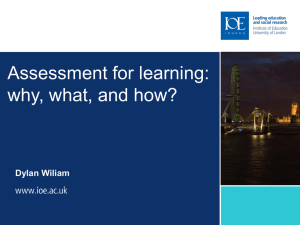
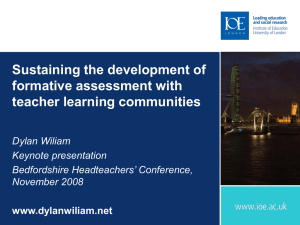
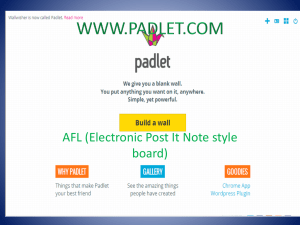
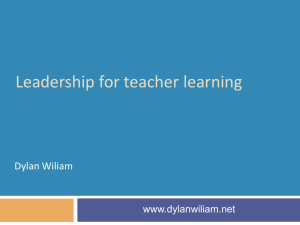
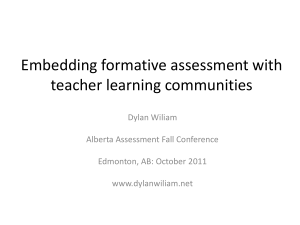

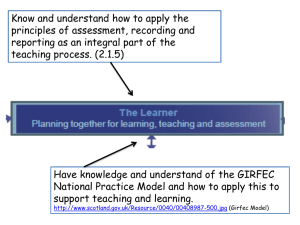
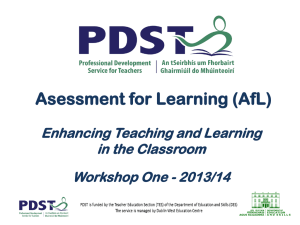
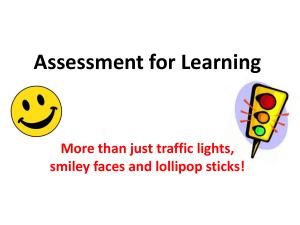
![afl_mat[1]](http://s2.studylib.net/store/data/005387843_1-8371eaaba182de7da429cb4369cd28fc-300x300.png)
